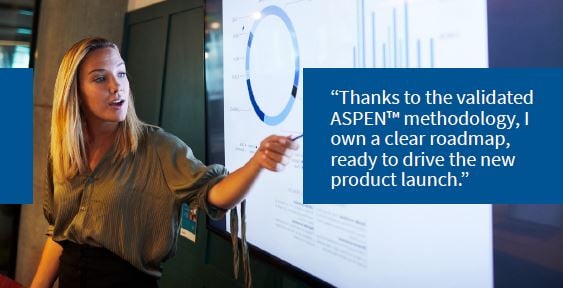Launching a new medical device is a complicated process. First, of course, you have to come up with a concept. What do you want your technology to do, and how will it do it? There’s that initial period of blue-sky thinking and prototype development, where you refine your technology and determine whether it’s viable. Then, once you decide to move ahead with commercialization, and you’ve achieved your safety and efficacy goals, the pace picks up, and suddenly you’re on a fast track to your launch target date.
“Launching a new medical technology is a massive project management challenge,” says Alain Segers, Founder and Managing Director at CRESCOMED, a boutique consultancy company specializing in supporting the launch of new medical devices.
MedTech organizations need to focus on the full launch process
MedTech organizations need to focus on the full launch process, from “proof to profit,” according to Segers, not just on the regulatory aspects, or lobbying. Another key success factor is to focus on market access awareness. “You need to inject market access awareness into the mix from day one,” says Segers.
The fact is, without that emphasis on market access from very early on in the process, product launches can fall flat. “When this isn’t a priority from the beginning, it can be a problem,” he says. “Sometimes organizations put all their focus on obtaining market approval, and they view that as a huge accomplishment. It is, but if they haven’t also been working on market access awareness, they can end up with a great product that no one is willing to buy – because the healthcare professionals have no financial incentive, or there’s no path to reimbursement.”
The most common pitfall
The most common pitfall, says Segers, is when companies think their product is ready, but the market is not. “The physicians and other healthcare professionals have not been primed, and the payers and the insurers haven’t been primed either. With budget cycles of multiple years and slow decision-making processes, this is a problem. These companies try a big splash with promotional activities, but there isn’t any traction,” he explains. “So they don’t get the revenue, and sometimes end up abandoning the project. Because who wants to continue to spend money on a product that doesn’t get any traction?”
Segers zeroes in on three factors that in his experience are critical to a successful launch:
- Start early on all the “downstream” steps. A lot of companies are so focused on product development that they wait too long on other aspects of a launch. Building awareness with physicians, and figuring out how reimbursement will work are activities that need to be underway long before you get market approval. “Once you get market approval, you won’t have time, because that’s when you need to start selling,” says Segers.
- Start working on market access on day one. The road to medical device success is littered with products that were safe, efficacious, and that patients and physicians loved – but that had one critical failing: no one was ready to reimburse the therapy. “If nobody is willing to spend money on it, you have no business,” says Segers.
- Make sure there’s a smooth handover from R&D to the commercial team. Many companies struggle with reconciling the different cultures involved in developing a product, from the R&D folks (often engineers), to the marketing, finance and sales people on the commercial side. But they all need to work smoothly together, throughout the process, to make the launch a success.
Another important factor is project management. Segers: “Many companies are excited about their invention, and they think the launch process will be straightforward. But the truth is that launching a new product requires support from multiple internal functions: regulatory, compliance, legal, the supply chain, finance, marketing, and more. It takes a strong leader, endowed by the organization with the authority to interact with all these functions, to successfully manage a project of this size and scope – someone who has a clear roadmap in mind, and keeps the organization on track all the time. Sometimes, if resources are limited, the task is handed off to product management, but product managers aren’t necessarily good at launching products. And they may not have the bandwidth, or authority, to connect all of these different functions.”
Organize the launch process effectively from the beginning
MedTech companies need to organize the launch process effectively from the beginning, ensuring that all aspects are covered and they’re fully ready by the time they reach the launch date, says Segers. “By putting in the effort upfront, and setting up a strong project management framework, you can ensure a much faster uptake of your technology, and a much faster ramp up of your income, once you launch. The whole point is to be ready on the first day you have the right to sell, with buyers, patients, and physicians lined up. That’s the thing about new technology. If you miss your window, you may never get the sales later. You only get one chance to get a launch right
|
|
Who is Alain Segers? A veteran in the MedTech sphere (with a career spanning companies like Cerus, CaridianBCT, Navigant Biotechnologies and Baxter), Alain Segers brings a wealth of scientific and commercial expertise to his role at CRESCOMED, which he founded in 2008. The company supports organizations launching new medical devices, with its comprehensive ASPEN™ process, which includes training, coaching and mentoring, and a large toolbox of ready-to-use templates and documents to direct and manage a launch. Alain is a generalist in the medical device / biotech space. He combines science with business and excels at product launches. He is very familiar with transplantation, transfusion, infectious diseases, immunology and is able to create and lead high-performing teams, with a strong cross-cultural awareness. |
Interested in setting up a workshop with Alain and your team? Feel free to contact Alain directly at alain@crescomed.com. If you would like Living Stone to participate in the workshop as well, contact Anne-Mie at anne-mie.vansteelant@livingstone.eu.






